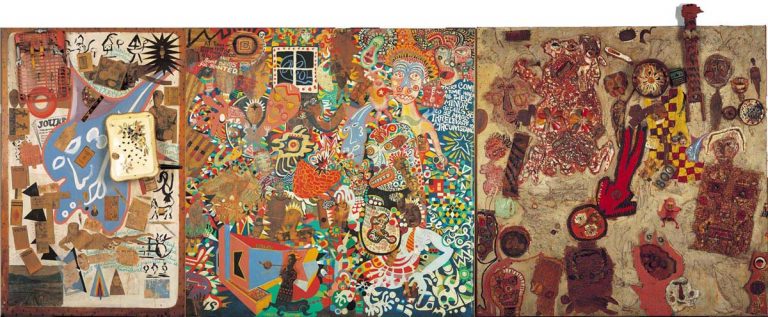We acknowledge the Traditional Owners of the land on which the Queensland Art Gallery | Gallery of Modern Art stands and recognise the creative contribution First Australians make to the art and culture of this country.

Colin Lanceley / Artist, right panel / Australia 1938–2015 / Mike Brown / Artist, centre panel / Australia 1938–97 / Ross Crothall / Artist, left panel / The Café Balzac mural 1962 / Left and centre panels: oil, synthetic polymer paint and mixed media collage on plywood; right panel: car duco, enamel paint, sand and plaster, oil, synthetic polymer paint and mixed media collage on plywood / Triptych: 195.3 x 487.4cm (overall); left panel: 183 x 117.5cm; centre panel: 184 x 184.6cm; right panel: 195.3 x 185.3cm / Purchased 1988 / Collection: Queensland Art Gallery | Gallery of Modern Art / © The artists
Colin Lanceley, Mike Brown and Ross CrothallThe Café Balzac mural 1962
Not Currently on Display
The Café Balzac mural is three panels painted and collaged by three young Sydney artists, Colin Lanceley, Mike Brown and Ross Crothall, working together on site in March 1962 during the early hours of the morning, after the last customers had departed from the Melbourne restaurant that gives the work its name.
Lanceley, Brown and Crothall had banded together the previous year under the name Annandale Imitation Realists, and were in Melbourne for their first exhibition which opened at the Museum of Modern Art in February 1962. The Café Balzac mural was completed after their exhibition with each artist working on their own panel (note that the three panels are different sizes).
The mural has several collaged attachments and is typical of the Annandale Imitation Realists’ work. A blue head recurs in each of the panels – in Crothall’s it is relatively large, medium size in Brown’s and quite small in Lanceley’s painting – where it acts as a unifying device. Although each panel is an individual work there is an overlying unity to the triptych which expresses something of the rationale of the Annandale Imitation Realists.
Colin Lanceley (1938–2015), Mike Brown (1938–97) and Ross Crothall (b.1934) were founding members of the Annandale Imitation Realists, a group of avant-garde Australian artists active between 1961 and 1963. Their work comprised collaborative paintings, improvised drawings and assemblages of rubbish from factories and shops representative of the material nature of contemporary culture. Mike Brown described the group’s output as follows:
At different times the work has been called Fine Art, and Anti-Art, and irresponsible Nihilism, and Junk Culture, and mere Junk, and Modern Totemism, and modern reliquary, and satirical goonery, and inspired or uninspired doodling, and Sheer Corn, and Dada, and Neo-Dada and Lah-de-dah and what-you-will. It has also been said to comprise a new Art Movement. God Forbid.1
Their name represented the radical nature of this style of art. ‘Imitation’ signified a wholesale rejection of the prevailing modernist cult of originality on the one hand, and of the principle of purity and truth to materials on the other. ‘Realism’ was equally provocative and signaled a reaction to the wave of abstract art dominating the Sydney art scene at the time. ‘Annandale’, a western suburb of Sydney, served as the group’s base.
Endnotes:
1. Mike Brown, quoted in Rudy Komon Gallery Presents the Subterranean Imitation Realists (formerly Annandale) [exhibition catalogue], Rudy Komon Gallery, Woollahra (NSW), May–June 1962.